With the FBI investigating a cyberattack that hit at least five banks, including JPMorgan Chase, many consumers are wondering what they can do to protect themselves if their accounts have been compromised.
Here are some steps to take:
Don't be taken phishing
Banks and other financial institutions do not send e-mails asking customers to input their account information, verify account data or update their records.
Such e-mails are known as "phishing attacks" because the hackers are fishing for information they can use to enter a network and steal information.
Consumers who get one of these e-mails should immediately delete it. Don't click on any links.
Often, the bank or financial institution will have information on its website about these types of fraud attempts. Open a new browser window, type in your bank's address and search for words such as "fraud" or "scam." When in doubt, call your bank.
JPMorgan has a page specifically addressing phishing. Here's the page Wells Fargo has up:
Check your statements every month
Many consumers don't bother to go through their bank and credit card statements each month. But that's a crucial way to detect fraud early on. Look at each transaction to ensure that you, not a fraudster, made it.
If something looks fishy, call your bank or credit card company.
"The sooner we know what has happened, the sooner we can begin to help you," Chase writes on its website.Read the rest of the story HERE.
If you like what you see, please "Like" us on Facebook either here or here. Please follow us on Twitter here.




No comments:
Post a Comment